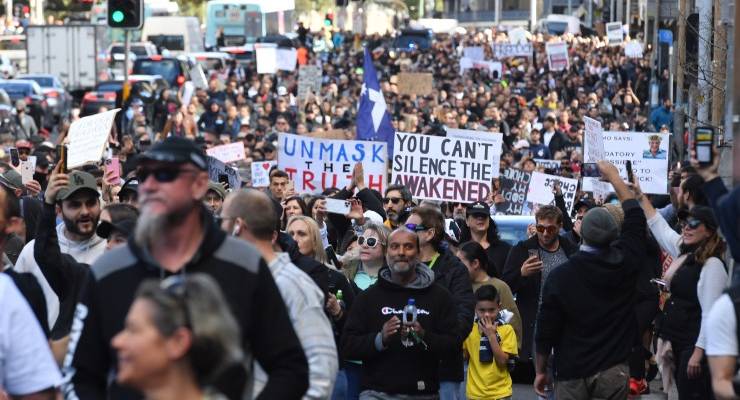
In the lead-up to last month’s lockdown protests, organisers touted the action as part of a “worldwide rally for freedom”. So was this the coming-out party for a global movement with chapters in Australia, or an example of local activists and protesters answering an international clarion call?
Analysis from the Australian Strategic Policy Institute (ASPI) suggests that groups behind the protest were homegrown but influenced by global players.
Analyst Ariel Bogle and researcher Albert Zhang looked at 14 groups (known as “channels”) on the Telegram messaging platform, comprising 12 Australian and two global channels involved in organising the July 24 protests. Telegram is preferred by conspiracy theorists, extremists and people with fringe beliefs because of its lax moderation.
In May, an investigation by publication Logically found that one group, the Free Citizens of Kassel, had seeded protests around the world by centrally creating Facebook events, Instagram accounts, Telegram groups and graphics for use in different locations.
Bogle and Zhang’s analysis of Australian organisations shows the online spaces used to organise the protests existed before the astroturfing efforts of the Free Citizens of Kassel. But the idea found a welcome home in the Australian Telegram channels as participants latched on to the branding, graphics and event idea.
“A 5 March 2021 press release from the ‘action group’ in Kassel, shared by the Melbourne channel, said it had received an overwhelming amount of support from many countries and was collaborating with organisers locally to deploy a wide variety of events,” Bogle and Zhang wrote.
Their analysis also shows cross-pollination between protesters and other fringe groups. Telegram allows users to easily forward messages between different channels. This feature is used widely to spread messages across the platform, as users can send it to thousands of people almost instantly.
In this case, the pair found that 24% of all messages in the channels were forwarded on from other places, including “QAnon-related channels, anti-vaccine groups, Australian far-right groups, international far-right groups and Australian politicians”. Messages from independent MP and misinformation superspreader Craig Kelly and the Russian state-controlled television state RT featured in the Australian channels hundreds of times.
While platforms like Twitter, Facebook and Instagram were important, Bogle and Zhang argue their analysis shows that Telegram played a crucial role in channelling the discontent of locals into action, with prompting from international activists.
“Telegram appears to have played an important role in facilitating coordination of protests and dissemination of material between global and domestic accounts,” they wrote.








Analysis by ASPI shows we need to buy a lot more submarines and fighter jets from their corporate sponsors.
To quote Mandy R-D, “they would say that, wouldn’t they?” – being a wholly owned, branch office of the “17 intelligence agencies” that ran the Russia (and now Iran!) collusion claptrap.
“The ..insert enemy de jour… are Coming!”
Please do not go along with the ASPI sub-text. Managed to mention Russia – but not Germany, RT mentioned but not Sky or Fox or any of the USA sources….
Surprised they didn’t mention China.
Barnaby Beetroot Anything that has a skirt will not tolerate Rhinehart and Forests buyer being named.
Pandemic means everywhere. The implication in the Sub Heading is buried in a post colonial, racist invasion sentiment aka Yellow peril Menzies. Don’t understand? The premise says the information comes from foreign inspiration; “overseas”. That xenophobic FEAR that only ‘White Supremacy understands’, whoops, I mean “only the Real Australian knows!”
But if this is a Real Pandemic, then the alert must include defence listening too any complexities of information and remedy or cures to defend 7 billion people. But, the fall back remains an all AUSTRALIAN fear of the Aliens. The Other. The CENSUS will ultimately restrict the recognition of “All Those Different coloured people that should go back where they came from” ehh
And then they go on to say it was seeded in Germany aka the whitest country on earth. Did you read it?
No surprises, the National Party had to expel 22 for saluting to the WW2 madman
Ah yes, the true patriots dancing to the tune of those who are intent on wrecking the joint, well done you freak jobs
Messages from independent MP and misinformation superspreader Craig Kelly and the Russian state-controlled television state RT featured in the Australian channels hundreds of times.
Treason/traitor is the word you’re looking for